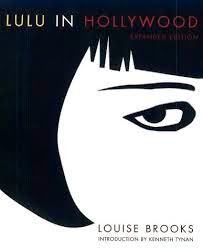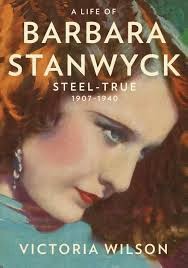Brooks, Louise. Lulu in Hollywood: Expanded Edition. Minneapolis, MN: University of Minnesota Press. 1974. Print
The Brooks family were poor English farmers who came to America on a merchant ship at the end of the eighteenth century.
Description:
I had never heard of the silent film actress Louise Brooks, nor seen any of her films until I read a review of the movie Something Wild. The writer noted that the distinctive shiny black bob hairstyle worn by good/bad girl Melanie Griffith was a Louise Brooks-style wig. Jet black, helmet-short with a slight curl forward to her cheeks, Brooks'/Griffith's hair signaled self-confidence, modern chic, and a bit of reckless danger. Griffith's alluring hair and innocent/naughty personality makes Jeff Daniels drop his normal life and take off with her on a roller coaster ride into the unknown of spontaneity, passion, and danger. I figured that Louise Brooks who first sported this cut must have been an equally exotic actress on the screen, so I looked her up and stumbled on Lulu in Hollywood, her autobiography.
Louise Brooks wrote many insightful articles about Hollywood, her early life, movie production and the people of the early 1920s. Her style is confident and brave, willing to call everything as she sees it. These articles were combined to create this book, the ultimate insider's guide to life in Hollywood and silent films.
Picked out from the chorus line in the Ziegfeld Follies in 1925, Brooks was offered, at eighteen, a five-year contract by both MGM and Paramount studios simply on the basis of her on-screen smoky looks and manner. She began making films for the glamor and for something to do, although her heart had been set on becoming a great dancer, having trained and toured with the prestigious Denishawn dance company that included Martha Graham.
The famous haircut came to be when the Kansas-born Brooks tried to shake off her flat accent, dull clothes, and mousy appearance to imitate the style, sophistication, and stature of her friend and famous actress, Constance Bennett. The change was astonishingly effective. Brooks' interview in Photoplay magazine sums up Brooks' striking aura during an interview conducted while Brooks reclined in bed:
But Hollywood soon lost its appeal to her. She constantly refused to be under the domination of any director, producer, or even studio, an attitude that soon made her an actress few wanted to work with. By the 1930s, her parts had dried up. She made her final eight movies between 1930-1938, then voluntarily left Hollywood for good, never looking back.
Brooks is a wonderful teller of tales, recalling with a photographic memory conversations and activities of Tallulah Bankhead, Marion Davies, William Randolph Hearst, Charlie Chaplin, Humphrey Bogart, and W.C. Fields among many others. There are sad recollections of suicides, of alcohol and drugs, and of doomed sexual encounters of those involved in the film industry. She also provides fascinating insider opinions about why the studios deliberately killed the careers of great actresses like Lillian Gish and Greta Garbo.
But there are also glowing tales of her friends like Chaplin, Fields, Bogart, and others. She candidly recounts her own relationships with directors, actors, and even stunt men, powerful men who financially and emotionally supported her to a life of style and luxury. Hers is a story of strength and confidence, of living in the Hollywood world of falseness and degradation.
It is an insider's story that is not about the making of movies but about the people who make them, their strengths and weaknesses, and the sordid environment of young people striving to succeed in their careers and relationships. It is not a pretty picture she describes, but to me it is a completely honest, fascinating, and lurid description of that world of film-making that seems so exciting, yet so harsh.
Her favorite quote from Goethe sums up her life:
Louise Brooks wrote many insightful articles about Hollywood, her early life, movie production and the people of the early 1920s. Her style is confident and brave, willing to call everything as she sees it. These articles were combined to create this book, the ultimate insider's guide to life in Hollywood and silent films.
Picked out from the chorus line in the Ziegfeld Follies in 1925, Brooks was offered, at eighteen, a five-year contract by both MGM and Paramount studios simply on the basis of her on-screen smoky looks and manner. She began making films for the glamor and for something to do, although her heart had been set on becoming a great dancer, having trained and toured with the prestigious Denishawn dance company that included Martha Graham.
The famous haircut came to be when the Kansas-born Brooks tried to shake off her flat accent, dull clothes, and mousy appearance to imitate the style, sophistication, and stature of her friend and famous actress, Constance Bennett. The change was astonishingly effective. Brooks' interview in Photoplay magazine sums up Brooks' striking aura during an interview conducted while Brooks reclined in bed:
She is so very Manhattan. Very young. Exquisitely hard-boiled. Her black eyes and sleek black hair are as brilliant as Chinese lacquer. Her skin is white as a camellia. Her legs are lyric."In her first twelve months in Hollywood, she made six full length films. While never a great actress, Brooks had a presence that could not be denied. Her combination of innocence and implied promise of sex made her a star, earning her $1,000 per week while other stars made half that amount. Her greatest triumphs, Pandora's Box and Diary of a Lost Girl, were filmed the next year in Berlin by Georg Pabst, the only director who saw her potential as an actual actress rather than a sultry, sexy piece of the scenery.
But Hollywood soon lost its appeal to her. She constantly refused to be under the domination of any director, producer, or even studio, an attitude that soon made her an actress few wanted to work with. By the 1930s, her parts had dried up. She made her final eight movies between 1930-1938, then voluntarily left Hollywood for good, never looking back.
Brooks is a wonderful teller of tales, recalling with a photographic memory conversations and activities of Tallulah Bankhead, Marion Davies, William Randolph Hearst, Charlie Chaplin, Humphrey Bogart, and W.C. Fields among many others. There are sad recollections of suicides, of alcohol and drugs, and of doomed sexual encounters of those involved in the film industry. She also provides fascinating insider opinions about why the studios deliberately killed the careers of great actresses like Lillian Gish and Greta Garbo.
But there are also glowing tales of her friends like Chaplin, Fields, Bogart, and others. She candidly recounts her own relationships with directors, actors, and even stunt men, powerful men who financially and emotionally supported her to a life of style and luxury. Hers is a story of strength and confidence, of living in the Hollywood world of falseness and degradation.
In writing the history of a life I believe absolutely that the reader cannot understand the character and deeds of the subject unless he is given a basic understanding of that person's sexual loves and hates and conflicts. It is the only way the reader can make sense out of innumerable apparently senseless actions.The book also includes a fascinating introduction to her life by movie critic Kenneth Tynan. He details his research into Brooks' life, his experience watching her on the big screen in the few remaining copies of her films, and then actually meeting her for an extended interview when she was in her sixties. One of the highlights of the book is when these two film lovers look through her photo collection while Brooks recounts the good and sordid about the people of her life.
It is an insider's story that is not about the making of movies but about the people who make them, their strengths and weaknesses, and the sordid environment of young people striving to succeed in their careers and relationships. It is not a pretty picture she describes, but to me it is a completely honest, fascinating, and lurid description of that world of film-making that seems so exciting, yet so harsh.
Her favorite quote from Goethe sums up her life:
For a person remains of consequence, not so far as he leaves something behind him, but so far as he acts and enjoys, and rouses others to action and enjoyment.
If this book interests you, be sure to check out:
Wilson, Victoria. A Life of Barbara Stanwyck: Steel-True 1907-1940
My favorite book of Hollywood, movies, actors, private lives the workings behind making a successful and not-so-successful film, and of course, the fantastic actress and person, Barbara Stanwyck. Very highly recommended. (previously reviewed here)

